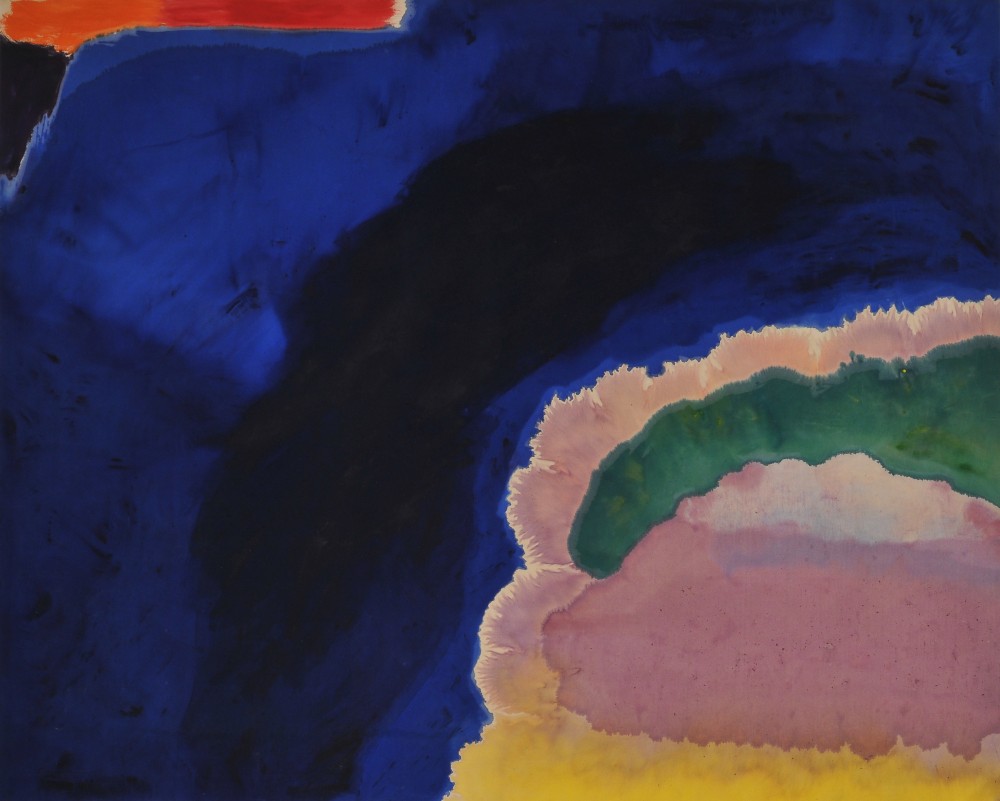
Ronnie Landfield, Blue Wall, 1970, Acrylic on canvas, 82 x 103 in (209 x 262 cm)
Ronnie Landfield was once an enfant terrible: In 1967, at the age of twenty, he was invited to exhibit in the Whitney Annual an eight-foot-square painting called The Howl of Terror, a terrifyingly mystical Abstract Expressionist work. Now sixty-nine, he’s mellowed into an elder statesman, yet his paintings, albeit today somewhat tamer, are still poetic, the artist still seeking, as he puts it, to “fill the void that defines who we are”—fill it with glorious color, his forte from the beginning.
Paintings such as Long Way Across and Twilight Rise, both 2015, are “constructions”—Landfield’s term—of broad, flat planes of stained canvas, sometimes thin, sometimes thick. The planes are piled atop one another, forming abstract landscapes clearly indebted to Color Field painting. (Indeed, Landfield calls the “initial Color Field painters and Abstract Expressionists” his “fathers and mothers.”) Reined in by their rather self-contained, flattened gestures, these works lack a certain haptic appeal of the great Abstract Expressionist canvases—their energy seems dimmed, like an incidental acknowledgment of a more aggressive past.
The exhibition was peculiar: Claiming to be a comprehensive survey of five decades of Landfield’s works, it offered only sixteen paintings, eight from 2015, with a scattering of earlier works: two from the 1970s, one from ’80, two from the ’90s, and the rest from the new millennium. (More historical works appear in the catalogue, but the focus there remains on the new paintings.) More unfortunately, the show set up an opposition between such lively, exciting earlier paintings as Blue Wall, 1970, and Returning, 1978, with their insinuating, lavish eroticism, and somewhat tamer, slacker paintings such as For David and Phillip and A Northern Voice, both 2015. The artist claims a kinship with van Gogh, but the range of Landfield’s feelings is narrower than van Gogh’s, and his colors less varied and startling. What Landfield calls the void or emptiness seems to have gotten the better of him.
His landscapes show him to be most concerned with the dramatic appearance of the physical world—its varying shapes and colors, seemingly at odds with one another but inevitably harmonious—rather than with the endless conflicts of incommensurate feelings in the psyche, however much he tries to use the former to convey the latter. If Landfield’s later landscapes are too balanced, not fraught with a tension that gave the earlier work emotional and confrontational power, perhaps it is because they are too dependent on the observed landscape for inspiration, rather than on the demands of his feelings. Nonetheless, Landfield’s paintings are important: They remind us of the importance of the natural environment, which seems to have become a distant abstraction rather than a life-giving reality in many people’s minds, confirming its diminished, threatened, exploited state in our technological society.